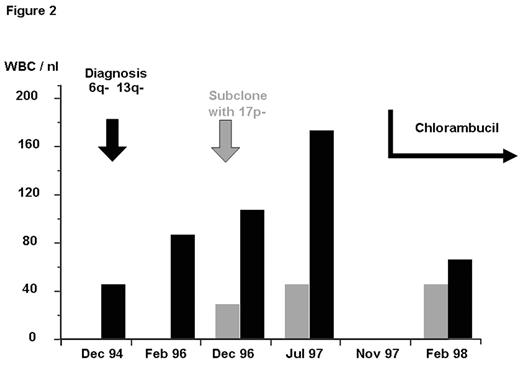Abstract
Genomic aberrations were analyzed by fluorescence in situ hybridization (FISH) at various time points during the disease course of 64 patients with chronic lymphocytic leukemia (CLL) from a single institution. After a median time of 42 (23–73) months, 11 of the 64 (17%) patients acquired the following additional aberrations: del(17p13) (n=4), del(6q21) (n=3), del(11q23) (n=2), +(8q24) (n=1), and evolution from monoallelic to biallelic del(13q14) (n=3). The baseline clinical characteristics of the patients with and without clonal evolution were not significantly different. Remarkably, clonal evolution occurred exclusively among cases with unmutated VH status (Figure 1). The group with clonal evolution showed a higher rate of progression in stage (82% vs. 28%), a greater need for treatment (100% vs. 62%), and a higher death rate (67% vs. 28%). The median survival time after the occurrence of clonal evolution was 22 months. Expansion of the clone with del(17p13) was observed in all patients during chemotherapy (chlorambucil n=4, fludarabine n=3, FC n=2, rituximab n=1) indicating in-vivo resistance to treatment (Figure 2). In multivariate analysis, clonal evolution was identified as independent adverse factor with regard to overall survival.
Disclosure: No relevant conflicts of interest to declare.
Author notes
Corresponding author



This feature is available to Subscribers Only
Sign In or Create an Account Close Modal